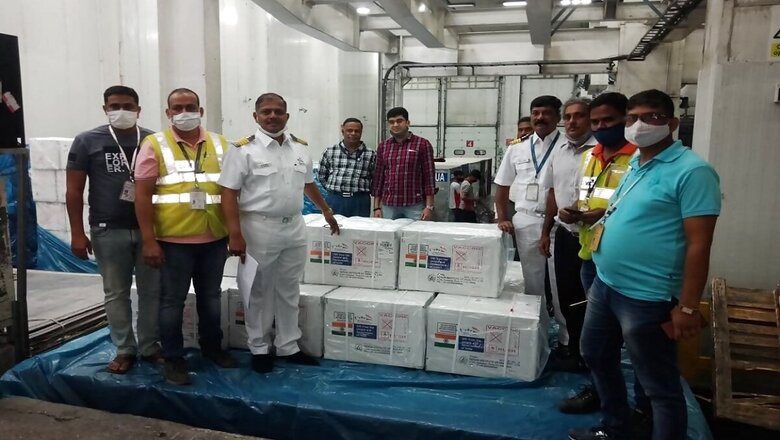
views
At the India-EU summit in early May, French President Emmanuel Macron declared, “India does not need to listen to lectures from anyone about vaccine supplies. India has exported a lot for humanity to many countries.” The sentiment was shared by most of the European leaders who took part in the extraordinary summit that saw Prime Minister Narendra Modi interacting with all 27 EU national leaders as well as presidents of the European Council and the European Commission. The EU leaders expressed their full solidarity with India at a time when the country is battling a treacherous second wave of the COVID-19 pandemic. Ahead of the summit, EU member states had mobilised more than €100 million worth of emergency medical equipment in support of India’s battle.
It may be difficult to comprehend at this moment of distress, but if not for India’s earnest global engagement over the past few years—and, its proactive assistance to many nations during the first wave of COVID-19—it would not have been possible to swiftly mobilise such remarkable amounts of global resources for India’s battle with the pandemic. From western nations to India’s partners in the Middle East and the Indo-Pacific, so many nations have rallied behind India.
Washington has mounted a full-scale mobilisation to help India with assistance worth nearly half a billion dollars so far, and is likely to go even higher. US President Joe Biden pledged his country’s steadfast support by saying, “Just as India sent assistance to the United States as our hospitals were strained early in the pandemic, we are determined to help India in its time of need.” The US Congress and the American corporate sector are ensuring rapid scaling up of support. The general sentiment is to reciprocate help in recognition of the role India played in assisting the United States as it battled the COVID-19 surge in 2020.
Countries in the Middle East, such as Israel, Qatar, Kuwait and the UAE, have responded to India’s call, and so have those in geographies to India’s east, including Japan, South Korea, Australia, New Zealand, Singapore, Thailand, Indonesia and Taiwan. Russia has extended its hand as well.
The India Story is Far from Over
The manifold assistance from all quarters is coming at a time when, as the second wave wreaks havoc on the lives of a greater number of Indians, partisan bickering on India’s handling of the pandemic is also growing. It is, therefore, more important than ever to underscore India’s role as a responsible global citizen, and its ability to cultivate partners and friends.
To be sure, many are of the view that India’s global “brand” has been dented by its handling of the second wave and the headlines it has generated. Just last year, India managed its response to the first wave more effectively than some of the world’s most developed nations. This efficient management was not glorified by the global commentariat nor did it change the global opinion on the country. The fact is, Brand India is not based on a highly efficient state to begin with. The world has already factored in India’s strong dual character. The country has the capability of mobilising global resources, transporting huge tonnage of critical equipment and inputs for its own needs, and to build a global coalition that can provide assistance in times of need. At the same time, its inability to deliver last-mile services to its individual citizens was glaringly obvious during the second wave and much is still needed on this count. This Indian paradox is likely to remain until the time governance capabilities catch up with the capacity of the state. This duality was a reality that was already being factored into most assessments of India across the world. India’s brand, as it evolved over the years, has been about its people and its ability to respond to adversities and thrive despite the governance challenges. Hence, amidst the predictions of doom and gloom, many would wager on the India Story getting back on track.
India’s diplomatic efforts have had a role to play in how the world has responded to India in the past and how it is engaging with the country today. New Delhi was adept to move adroitly from the Trump dispensation to that under Biden in Washington. The fact that President Joe Biden, within just two months in office, decided to upgrade the Quad engagement to the leaders’ level, and that his administration has been engaged with India substantively across all domains, is a testimony not only to India’s growing centrality in America’s Indo-Pacific strategy, but also to its ability to convince the United States of the same. India’s determined efforts to build its clean energy portfolio and embrace a green future will further strengthen this bilateral relationship and its post-pandemic recovery. The US and India are already working on a new partnership to scale up green investments and technology collaborations in this Decade of Action. And, in a turn that was as unexpected as it was unprecedented, the United States has also announced its support for a waiver of COVID-19 vaccine patents, in response to a proposal spearheaded by India and South Africa at the WTO. Even as the pandemic has raged, India’s diplomatic engagements with other major geographies such as the Indo-Pacific, Middle East and Europe have continued unabated.
Many deride India for accepting foreign aid from many countries at this moment of crisis after declining the same for years. Yet, such humanitarian assistance from India’s allies and friends must be recognised for what it is—a part of the “mutual assistance framework” resulting from India’s support to the rest of the world last year and more broadly in the recent past. For instance, India’s Humanitarian and Disaster Relief (HADR) assistance within its neighbourhood has grown in leaps and bounds over the last two decades mirroring its rise as an economic power, with increased engagement post 2014 with Prime Minister Modi emphasising a ‘neighbourhood first’ policy. Its investments in connectivity projects, critical infrastructure, and social infrastructure in its neighbourhood is well documented and points to India embracing a comprehensive development partnership strategy in its region and beyond. India’s approach to development aid and infrastructure development is based on financial, environmental and social sustainability unlike the predatory policies of some other powers. With its Quad partners as well, India has been trying to leverage its ties for addressing the challenge of sustainable development, quality infrastructure investment, and humanitarian-assistance and disaster-relief in the wider Indo-Pacific.
India’s vaccine diplomacy is evidence of this new mood in New Delhi. While there are legitimate questions on India’s vaccine programme, its support to some of the countries within the Vaccine Maitri programme must not be a part of it. As Ursula von der Leyen, President of the European Commission stated early on, “A global pandemic requires a world effort to end it—none of us will be safe until everyone is safe.” Out of India’s shipment of 66.3 million vaccine doses, 10.7 million were sent as grants to developing- and low income countries and 19.8 million doses were dispatched as part of the UN-led COVAX initiative to bridge the vaccine divide, where rich countries like Canada and the UK have enough doses to vaccinate their entire population nine and six times over respectively, while countries like Chad and Tanzania have no vaccines at all. Vaccine diplomacy also makes economic sense as studies show that if low- and low- middle income countries are not able to vaccinate a critical mass of their populations, high-income countries (HICs) would be severely impacted as a consequence. According to a Rand Corporation study, this could end up economically costing (cumulative) the top 30 HICs US $258 billion in 2023-2023, a whooping increase from US $82 billion in 2020-2021.
Political debates in India about the handling of the second wave of COVID-19 will, and should, continue. What should not be lost in the din is the recognition that foreign policy and global partnerships play an important role in managing domestic crises. The global outpouring of support is a function of India’s attempt to carve out for itself a unique standing in the global hierarchy. India’s “all-in” engagement has ensured that when the chips were down, the world put its money on an Indian recovery. India’s next challenge would be to create an enabling framework that would allow the world to partner in its inevitable economic growth and resurgence. For all the challenges India has faced in the last few weeks, news of the demise of the India Story are greatly exaggerated. New Delhi is still, perhaps, the most promising game in town.
This article was first published on ORF.
Read all the Latest News, Breaking News and Coronavirus News here. Follow us on Facebook, Twitter and Telegram.



















Comments
0 comment